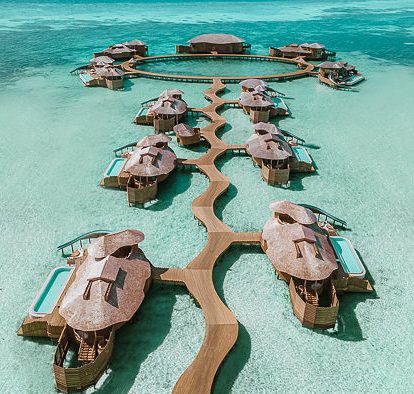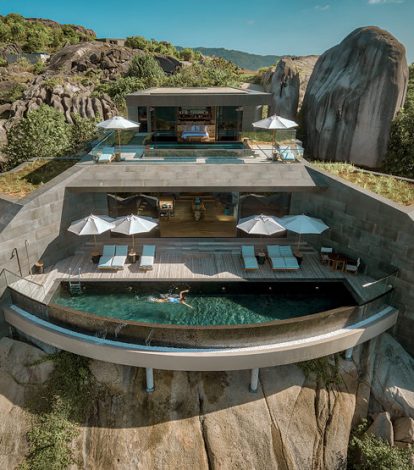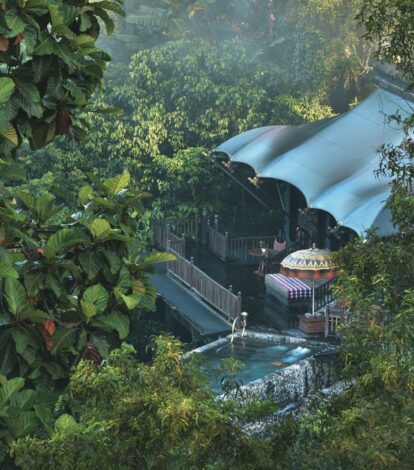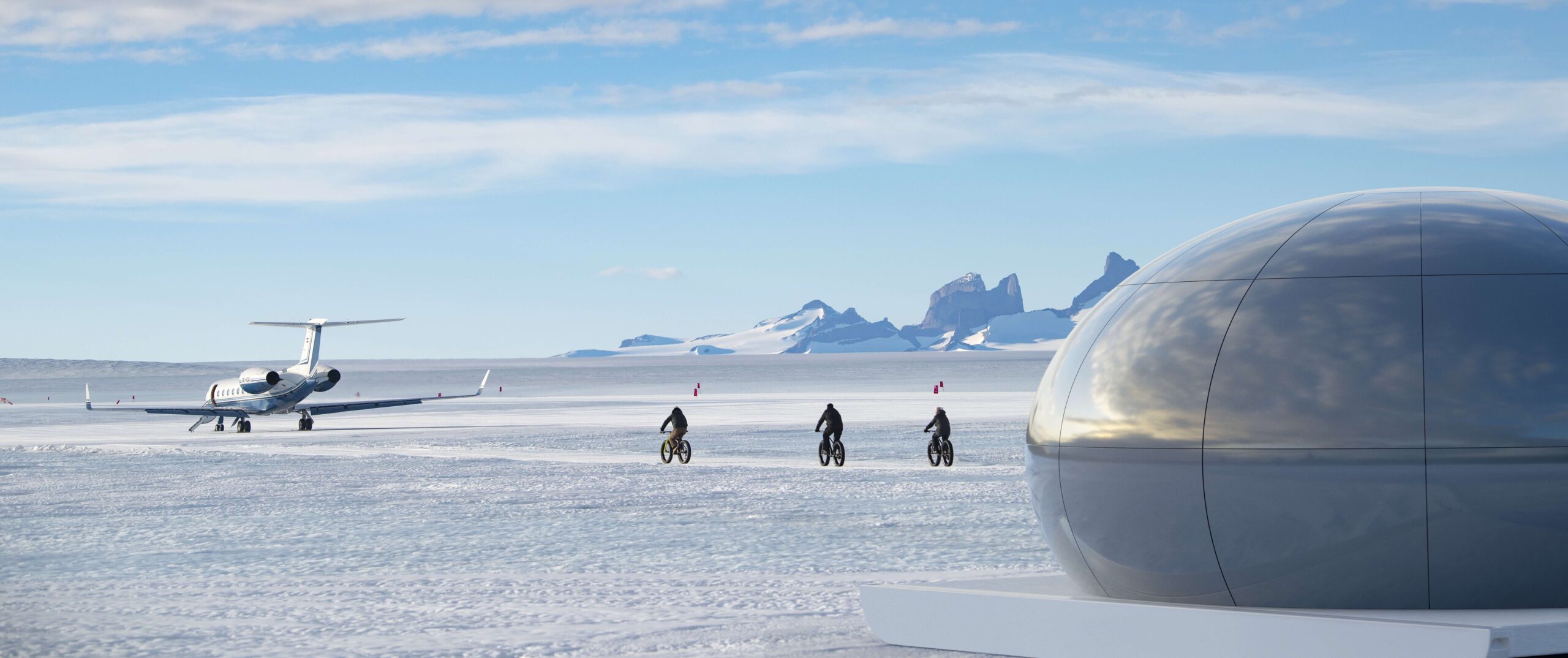Environmentally designed new hotels, self sustainable islands and some pioneering nature conservation are among the travel initiatives we’re following in 2024.
Sustainability is high on everyone’s agenda in travel. It’s something we now demand, rather than only desire.
Almost every hotel claims to be sustainable. In reality, almost every hotel does something that’s sustainable. It’s important to question the actions, to really ask, what difference does it make.
In 2024, removing plastic straws and changing towels less frequently isn’t going to cut it. We’re inspired by hotels setting new sustainability standards, those who lead the way to a cleaner, greener future for luxury hospitality.
Environment Design & Construction
A vast portion of a hotel’s lifetime carbon emissions come from construction. And a more environmentally friendly construction supports less carbon intensive operations.
Now we must start to ask not only what do you do, but how did you build it?
Six Senses Southern Dunes, Saudi Arabia

The first hotel to open at the ambitious Red Sea project, this desert resort has established a benchmark for every hotel to follow in Saudi Arabia.
The remote resort is 100% powered by an onsite solar farm. Architecture is centred upon maximising natural light and minimising energy requirements.
Copper-silver ionisation is used instead of chemicals to clean the water of 40 pool villas.
It’s the first hotel in the region to achieve LEED platinum certification (Leadership in Energy & Environmental Design). This is the global standard for green building and construction.
Forestis Dolomites, Italy

Forestis achieved carbon-neutral construction and is also 100% powered by renewables, including wood pellets, hydropower and wind turbines.
It’s a hotel completely in tune with nature. A bottle of Plose mountain water outside Italy costs €10. At Forestis it’s the water you bathe, shower and swim in.

All construction materials were locally and sustainably sourced, which is both better for the environment and enhances harmony between the hotel and its breathtaking surroundings.
Most notably they used local wood and replanted two saplings for every one tree that was felled. The minimal interior design is also defined surrounding nature and most of the furniture is recycled and repurposed.
Self Sustainable Islands
While lounging in an overwater villa pool, gazing out to endless ocean turquoise, with an extravagant drink…did you ever wonder about the operations behind your island holiday?
Soneva Secret, Maldives

Soneva has long set the standard for responsible barefoot luxury in the Maldives.
All Soneva resorts have a 2% environment levy, supporting marine conservation projects and coral restoration across the oceans.
All operate carbon neutrally, supported by the use of on-site solar farms. For example, Soneva Jani reduced their diesel consumption by 300,000 litres annually, by switching to solar power. 90% of solid waste on the remote Soneva islands is recycled.
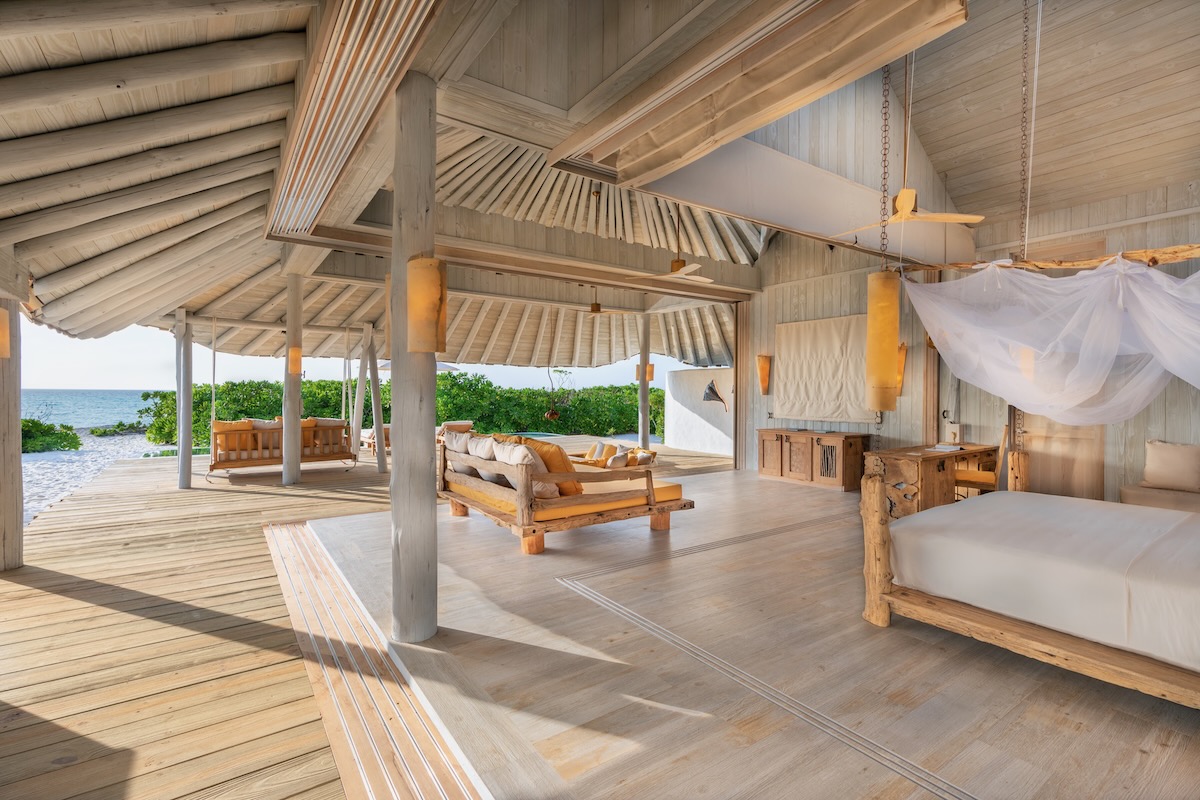
Opening February 10th is Soneva Secret, the only resort on the Haa Dhaalu Atoll, some 75 minutes by seaplane from Male. There are only 14 villas out here.
Such a remote location creates more exclusivity and tranquillity for guests. But being self-sustainable out here will require Soneva to take their initiatives further. We can’t wait to check it out!
The Brando, French Polynesia

Few resorts are as remote as The Brando, located on a vast lagoon and series of islets in the South Pacific.
The resort is powered by 4000 solar panels, with electricity stored in recycled lithium batteries. Most food comes from the island gardens and surrounding waters, with all food waste returned as compost.
Wastewater is treated and returned to the island. Drinking water is desalinated, definitely not imported in bottles.

Cool deep ocean water is pumped up to the island and circulated through the buildings. This requires ten times less energy than a typical air conditioning system.
The Brando was the first resort in the world to achieve LEED Platinum and we love their transparency. Carbon neutrality is their goal and they accept there is still a long way to go.
Nature Conservation & Supporting Local Communities
Some hotels and lodges are not only minimising their negative impact, but maximising their positive impact. With some remarkable results.
Singita Lodges in Africa

Guests at Singita’s lodges pay substantial conservation fees. This help to pay for the land, keeping it for wildlife, rather than people or industry.
At Singita Grumeti a vast barren land has been transformed into a thriving habitat for buffalo, elephants, lions and rare black rhinos. It’s been so effective that the great wildebeest migration now travels further west, to this new Grumeti part of the Serengeti ecosystem. We love Singita Sasakwa lodge here.
At Singita Pamushana Lodge in Zimbabwe, each stay funds the Malilangwe Trust, which aims to increase the population of black and white rhinos.
Guests can spend a day with an anti poaching unit and see how conservationists enable rhinos to flourish. It’s been so successful that rhinos from Malilangwe are now helping to repopulate rhinos at reserves all across Zimbabwe.
Angama Lodges in Kenya

Angama operates three of the best contemporary safari properties anywhere in Africa.
Angama Mara is perfect for a first-time safari, including with kids. Angama Safari Camp is the most exclusive place to stay on the Masai Mara. The new Angama Amboseli is the first community-owned conservancy in all of Kenya.

All three properties are deeply rooted in their local communities. This is great for guests, who enjoy authentic activities with local Masai people.
To walk with a Masai in the Masai Mara is one of Africa’s great travel experiences.
It’s great for the community too, who are supported with clinics, schools, clean water systems and other infrastructure not normally available in such remote, wildlife-filled areas.
Auditing, Benchmarking and Moving Forward
Sustainability in luxury hospitality doesn’t have a predefined end point. The bigger picture is not about a few pioneering hotels, but the sustainability of all the world’s hotels.
How does a hotel brand with many properties become sustainable, when they’re relatively new to the sustainability world?
Belmond Hotels & Resorts

Belmond has partnered with EarthCheck, the world’s leading advisory group for sustainable tourism organisations.
This partnership means Belmond can scientifically quantify and benchmark sustainability across all their properties. It’s an essential first step towards measuring impact.
One of Belmond’s 2024 initiatives is a Gastronomy Academy that will guide how food and drinks are managed, in ten of their properties.
Increasing renewable energy and reducing freshwater withdrawal are among the priorities as Belmond seeks to improve its environmental performance.
Capella Hotels

Capella Hotels have also partnered with EarthCheck. The process of measuring impact helps hotels to make more sustainable decisions at all points in construction and operations.
One example is Capella have revised the supply chain across their properties. The aim is to maximise a circular economy, ensuring more of guests’ money stays in local communities.
Prioritising local suppliers means a more authentic experience for guests too, whether it’s interior design or fresher local food. It also hugely reduces packaging and the carbon footprint of transporting goods.
Supporting the Sustainable Future of Tourism
Continuous improvement is the only approach to sustainability. It’s not about yes or no, it’s about everyone doing what they can.
EliteVoyage was the third travel agency globally to join Pristine Mood, the world’s first sustainability program specifically for luxury hospitality.
We are on the path and we know there’s so much more we can do, which we will be doing in the coming months and years.

